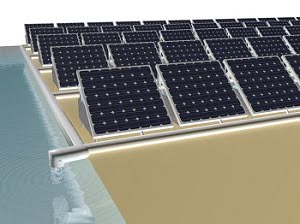THUWAL, Saudi Arabia, July 19, 2019 — Researchers at King Abdullah University of Science and Technology (KAUST) have developed a multifunctional device that captures the excess heat shed by photovoltaic solar panels and uses it to desalinate seawater, without affecting the panels' electricity output.
Wenbin Wang, a doctoral student in professor Peng Wang's labs at the university's Water Desalination and Reuse Center, said water and energy production is deeply intertwined. Conventional solar farms use fresh water to wash dust from the panels. Water desalination plants consume a great deal of electricity to produce fresh water from seawater.
"The water-energy nexus is one of the main issues threatening sustainable global development," Wenbin said.

A solar farm of photovoltaic panels with a heat-driven seawater desalination system beneath each panel could co-generate renewable electricity and fresh water in arid coastal areas. (Courtesy of Wenbin Wang)
The researchers' device could help solve this problem. Commercial PV panels turn sunlight into electricity with a maximum efficiency of 20%. The remaining 80% is wasted, mainly shed into the surrounding air as heat. The device captures this heat and uses it to generate fresh water.
The researchers built a device in which a stack of water channels, separated by porous hydrophobic membranes and heat conduction layers, were attached to the underside of a commercial PV panel. Waste heat from the panel vaporized seawater in the uppermost channel; the vapor crossed the porous membrane and condensed as fresh water in a clean water channel just below. As the vapor condensed, its heat passed through a thermal conduction layer to the next seawater channel, recycling the energy to purify more water.
Using three stacked layers of water distillation channels, and passing the energy from layer to layer, the device produced up to 1.64 liters of water per square meter of solar panel surface every hour. That is more than double the water output of traditional solar stills, which use a one-stage design, Wenbin said. The PV panels' electricity output was unaffected by the water desalination taking place beneath it.